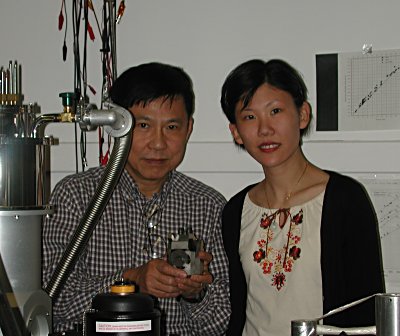New porous materials could make the transport, storage and delivery of hydrogen much easier and open the door to what has been described as the hydrogen-based economy. The hydrogen economy could go some way to side-stepping certain problems associated with dwindling petroleum reserves, pollution, and climate change. Hydrogen-based fuel cells, for instance, could reduce greatly the impact of vehicle pollution in urban environments. The trouble with hydrogen though is finding a safe and effective transport and storage medium.
Many types of material have been investigated as possible storage media from high-surface-area carbon materials to single-walled nanotubes. Now, the storage of hydrogen at medium to low temperatures has been demonstrated by US researchers. They have developed a new method of storing large quantities of hydrogen gas in crystalline compounds. The results may lead to the development of new technologies that exploit the efficiency and low-pollution properties of hydrogen.

Dave Mao
Currently, most hydrogen power systems use liquid hydrogen, a very cold (20 K) liquid that requires a lot of energy to produce. One alternative might be to trap molecular hydrogen (H2) in crystalline solids where a framework of water molecules encloses molecules of the gas. Until now, hydrogen was thought to be too small a molecule to be contained in a clathrate hydrate in this way. Ho-kwang Dave Mao and Wendy Mao of the University of Chicago and the Geophysical Laboratory at the Carnegie Institution of Washington thought differently and have recently reported that hydrogen clathrate hydrate, a crystal made up of units containing one hydrogen molecule and two water molecules, H2(H2O)2, can be prepared and stored comparatively easily.
To create these crystals, the team compressed hydrogen gas and ice with a pressure of 2,000 to 3,000 atmospheres. Using liquid nitrogen to cool the crystals to 77 K, the researchers showed that the hydrogen was retained even after the pressure was reduced to ambient levels. When the researchers raised the temperature to 140 K, the stored hydrogen was released.

The father and daughter team developing hydrogen storage materials
Theoretically, the hydrogen gas that can be released from this medium could then be channelled to a generator. At 50 grams of hydrogen per litre of crystal, the clathrate does not contain as much hydrogen by weight as liquid hydrogen, and may be difficult to produce in large quantities. However, the researchers say that related clathrate crystals that use hydrocarbons, such as methane and octane, rather than water should be able to hold more hydrogen.
This result could be a first step toward an alternative way of storing environmentally friendly hydrogen gas, says Dave Mao, although the researchers admit that the field is still in its infancy and that much work is still to be done before the cash cow of the hydrogen economy becomes comes home.
Further reading
Read article
http://intl.pnas.org/cgi/content/abstract/0307449100v1
Ho-kwang “Dave” Mao
http://www.gl.ciw.edu/people/hmao
Intute hydrogen resources
http://www.intute.ac.uk/sciences/cgi-bin/browse.pl?id=78
Suggested searches
fuel cells